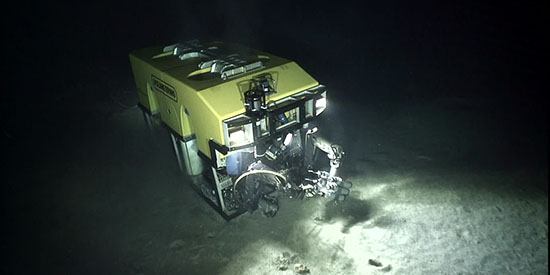Deep sea research shows oil and gas sector could help environmental goals
Media release
Environmental science must collaborate with the oil and gas sector if the mysteries of the deep sea are to be revealed, according to some of the world's leading marine scientists, who have jointly made the call in a new paper.
The paper, recently published in the journal Science of the Total Environment, examines how remotely operated vehicles (ROVs) - commonly used for offshore oil and gas operations in the world's oceans - could be harnessed to answer some of science's biggest unanswered questions.
Lead author Associate Professor Peter Macreadie, Director of the Blue Carbon Lab in Deakin University's School of Life and Environmental Sciences, said deep sea research was limited due to the enormous cost of sending equipment down to these depths.
"There's more known about the moon than there is the bottom of our oceans," Associate Professor Macreadie said.
"Just 0.01 per cent of the deep ocean floor has been sampled and explored in detail. Yet we know that global oceans have impressive biodiversity, with more than 200,000 marine species described, and an estimated hundreds of thousands more yet to be described."
Associate Professor Macreadie said ROV systems were incredibly useful to marine scientists as they acted as 'eyes and hands in the sea', equipped with cameras that can stream live video to the surface, and some which pilots could manoeuvre to interact with their surroundings.
"Sophisticated deep-sea ROVs cost about $200,000 per day to run, so they could never be afforded by research teams, but they are regularly used by oil and gas companies for exploration, monitoring and maintenance," he said.
"That includes here in Australia where large oil and gas rigs are mostly concentrated off the coast of WA, as well as some in the Bass Strait. Industrial ROVs collect millions of observations of our oceans each year, and we want to capitalise on that.
"What we're talking about is a rare and unusual collaboration between two strange bedfellows, the oil and gas industry and scientists, because no one is exploring the deep sea better than that sector."
Associate Professor Macreadie said collaboration between the two groups had already led to important research most notably through SERPENT – the Scientific and Environmental ROV Partnership using Existing Industrial Technology.
He said this kind of work had resulted in dozens of new species being discovered so far, as well as sightings of deep sea animals in action.
"Venerable marine scientist Richard Harbison perfectly encapsulated the importance of these observations when he said: 'Sampling with plankton nets is akin to flying over London with a grappling hook. You might pick up hats and umbrellas and a few tree branches, but you can only speculate as to where hats belong, and what umbrellas are good for.'
"In contrast, direct imaging using video and still cameras mounted on ROVs can provide a completely different picture of life in the depths. These types of in situ observations have contributed to a rapid increase in our understanding of deep-sea ecology.
"One new species' discovery a kilometre down off coast of Angola went viral due to its close resemblance to the 'deity' of the so-called 'Church of the Flying Spaghetti Monster'.
"This shows how captivating observations of unusual deep sea organisms can be to the public."
To develop the new paper, the Oceans Institute at the University of Western Australia brought together a group of international ROV experts from academia and industry to identify the top 10 issues facing the ocean that could be addressed through increased access to industry ROVs.
The priorities fell under three main themes: improving understanding of the deep ocean and the animals that reside there, investigating how the deep ocean is changing, and identifying how ROVs can support the development of the deep ocean 'blue economy'.
This includes regenerating offshore infrastructure for 'rigs to reef' projects by harnessing the 'accidental' ecosystems they develop through providing protective habitats for fish and rare coral, and also examining unique deep sea organisms whose chemicals can be isolated for pharmaceutical and industrial applications.
"To get industry onside in helping us reach these goals, we must highlight the value of this data, as well as build trust and understanding so that data can be more freely shared. That could even result in training ROV pilots in scientific data collection," Associate Professor Macreadie said.
"As well as generating data that is valuable for science, industry would greatly benefit by working with researchers to increase their understanding of the environment they operate in and their impacts upon it.
"It also allows industry employers, contractors, regulators and key stakeholders to get a better understanding of the rich and diverse habitats that occur around deep water infrastructure."

